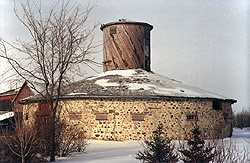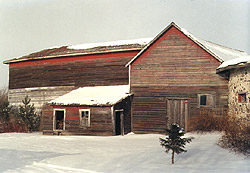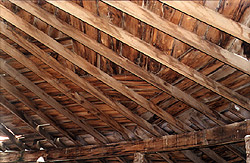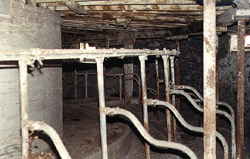
The Bell-Walker Barn in winter;
note the diagonal siding on the silo.
|
Travelers on Hwy. 56 south of the Qu'Appelle Valley near the town of Indian Head may be puzzled at the incongruity of a round stone barn with a cylindrical wooden silo rising out of the center. The barn dates from 1882 and is one of the last buildings on the Bell Farm, one of the so-called "Bonanza farms" that were attempted at the end of the 19th century in the west of Canada and the United States.
Today we would label these large operations by the almost pejorative term of "corporate agriculture" or "factory farming." In 1882 this 53,000 acre wheat-growing enterprise was the ambitious attempt by Maj. Wm. Bell to tame the newly opened prairies of Western Canada. William Bell was born at Brockville, Ontario and after spending part of his early adulthood in the U.S. returned to Canada to join the army and end the Fenian raids of Irish-Americans into Canada.
The 35-year old Maj. Bell decided in 1881 to seek adventure and fortune in the west. He walked and rode from Brandon, Manitoba, to where the Canadian Pacific tracks ended, another 200 miles further west. Bell studied the soils along the already-designated route of the CP to a point marked only by an Indian skull suspended on a post-modern day Indian Head, Saskatchewan. It was here next to the route of the CP that he found suitable land for grain production.
Maj. Bell quickly organized investors in Canada and the United States, and purchased about 100 square miles or 53,000 acres of open prairie from the CP and the Canadian government at $1.25 per acre. By the spring of 1882, even before the CP tracks extended to Indian Head, the Maj. was breaking (the first plowing) the virgin prairie.

The adjoining frame barn; just a band of
red left where protected by the overhang. |
At one time 200 horses and 73 plows operated by 100 men were employed in breaking. It was said that some fields were so long that the plowman spent the morning to reach the end of the field, had lunch and rested the team, and spent the afternoon returning to his starting point. The breaking operation cost $3.50 per acre - almost three times the cost of the land!
While his teams were breaking the prairie, Maj. Bell began the construction of buildings befitting his ambitions. First was a 16-room, two-story stone house measuring 34' x 40' with a 23' x 44' wing. Also, constructed were four stone and two frame five-room cottages, an ice house, a cow barn, and a chicken house. None of these have survived to the present.
Also built in 1882 was a circular stable of fieldstone with a diameter of 67'. It featured the central silo of many round barns, 100 tons of hay storage, an office, and bins for 4,000 bushels of oats, the preferred horse feed. The round barn's most unusual feature was that it had no windows - only small holes that resembled gun ports. There is no explanation for the fortress-like construction, and no record of a shot ever being fired from the openings - at least in anger. All the ports but one have long been filled with masonry or replaced with windows.
A contemporary account further describes the stable as: "…a circular stone building with square holes at intervals all around it for light and ventilation. There are stalls for 36 horses…and it is as clean as a parlour. The feed is kept in the upper story and is conveyed through a chute to the lower. One man tends to the whole stable."

The roof framing;
note the pattern of the roof boards. |
Maj. Bell organized the farm along military lines. There were managers for each of five divisions, each section within a division comprised 213 acres and this was further divided into three parts of which one would be left fallow in a given year to accumulate moisture. Following the military analogy, the Maj., operating from command headquarters, communicated by telephone each evening with the division managers. The telephone, as a management tool only seven years after Alexander Graham Bell (no relation) had demonstrated it at the Philadelphia Centennial Exposition, was certainly "high tech" for that time and place, and must have been a source of wonderment to the farm laborers.
Harvest was impressive. One visitor reported 26 binders operating in a field like a battalion as they attacked the standing grain, cut it, mechanically bound it into sheaves and cast them on the ground for hand shocking. In the first crop year of 1883 the yield was 20 bushels per acre, which amounted to 30,000 bushels of No.1 hard spring wheat. The price at Indian Head was a profitable 88 cents/bushel for milling and $1.25 for seed. The Bell Farm appeared well on its way to justifying the Major's expectations.
The 1884 crop seemed to further confirm the Major's enthusiasm. It was estimated at 30 bushels per acre before an early freeze made the wheat fit only for animal feed. The Major knew his costs of production to a fraction of a cent - seven cents for labor, three and six-tenths for horsepower, three and three-tenths for maintenance of laborers and 20 cents for seed, depreciation and interest. The costs totaled a low 34 cents but frozen wheat wasn't worth even that much. The quality of the 1884 harvest was so low that it couldn't bear the cost of rail shipment to the East.
In March 1885 the Northwest Rebellion of the Metis occurred in southern Saskatchewan. The result was that only 1000 acres of wheat were sown - far too little to contribute needed revenue. The Rebellion and weather problems continued to plague the enterprise until in 1888, only five years after its founding, the sheriff seized movable assets of the Bell farm to satisfy back wages and bank notes. These assets consisted in part of 41 grain binders, 60 engines (probably steam), six threshing machines and even 140 cords of wood.

The stanchions arranged around the center silo.
|
There were attempts to downsize and reorganize. The 54,000 acre corporate farm was reduced to 13,000 acres owned personally by the Major, albeit heavily mortgaged. There were good years such as 1888 when wheat averaged 27 bushels per acre and sold for $1.05, and poor years such as 1894 with one of the worst recorded harvests for the region. Concurrently, the price for milling quality wheat fell to 35 cents. Unfortunately the economic effects of the bad years outweighed the good seasons and in 1895 Bell's horses, cattle and even household furnishings were auctioned. In the fall of 1896 the farm was sold in smaller parcels and the dream of Maj. Bell ended.
The indomitable Major went on to produce bricks in Ireland from bog peat, to establish a lumber venture in the Bahamas, a coal mine in Alberta, and was a member of the Winnipeg Grain Exchange until his death in 1913.
There have been several Indian Head citizen initiatives to declare the Bell Farm Round Barn a Heritage Site. The goal of these movements is not so much to save the barn for its architectural merit, but to perpetuate the memory of Maj. Bell and his demonstration of the feasibility of producing grain in the Indian Head area. To date none of the local municipalities have been willing to undertake the project and the barn continues to deteriorate.
By Charles Leik, April 2001. Material for this article was contributed by Dan Walker, Indian Head, the Bell Barn's current owner.
|
![]()
![]()
![]()
![]()